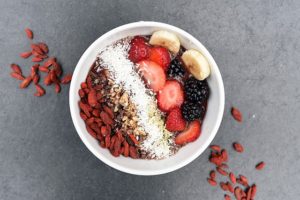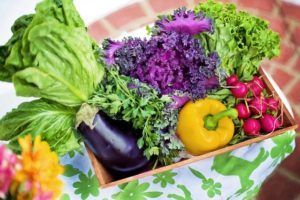OK, nobody wants to talk about this, but it’s important. The word for today is fiber. That’s right—roughage—nuts, twigs, berries, and whole grains, and why they’re good for you. Fiber is the indigestible part of the plant foods you eat, and it’s your best friend.
I didn’t give fiber much thought until after my first colonoscopy more than 15 years ago. As the doctor was giving me the low down on how healthy  my gut was, he said that I should try to eat 25 grams of fiber a day. What?? I remember thinking if I did that I’d be eating nothing but fiber! In hindsight, I realize that 25 grams is a goal, just like eating five fruits and vegetables a day–some days you do and other days…you almost do. And really, if you eat right, 25 grams of fiber is totally doable.
my gut was, he said that I should try to eat 25 grams of fiber a day. What?? I remember thinking if I did that I’d be eating nothing but fiber! In hindsight, I realize that 25 grams is a goal, just like eating five fruits and vegetables a day–some days you do and other days…you almost do. And really, if you eat right, 25 grams of fiber is totally doable.
Why should fiber be on your Must Eat list? There’s some good reasons:
- For anyone watching their weight, fiber is your pal because it helps you feel full and curbs your appetite. Essentially, you feel like you’ve eaten more when you eat high-fiber foods.
- Fiber also aids the digestive process by helping food move through your gut.
- It gives bulk to your stools and decreases the risk of polyps, colon cancer, and diverticulitis (little pockets in your colon where food can get trapped).
- Fiber can also increase your levels of good cholesterol and decrease your bad cholesterol.
- As you digest fiber, it helps increase the amount of good bacteria in your gut.
Fiber is also beneficial because it binds to stuff, like carcinogens, heavy metals, and pesticides in the foods you eat. However, fiber also binds to the  minerals in your food. This means that you may want to separate the time between a high fiber meal and one that is rich in calcium, magnesium or when you take vitamin supplements.
minerals in your food. This means that you may want to separate the time between a high fiber meal and one that is rich in calcium, magnesium or when you take vitamin supplements.
There are two different kinds of fiber, one of which is called soluble fiber. This means that it can take on water and bulk up your stool. Soluble fiber is the kind that’s really good for decreasing cholesterol and improving heart health. Oat bran is a really good source of soluble fiber, but it is also found in high amounts in apples, spinach, almonds, and cruciferous vegetables, like broccoli.
The other kind of fiber is insoluble. Insoluble fiber doesn’t degrade as much in the gut as soluble fiber, but you need it for digestion. It helps move food through your gut, and helps “scrub” clean your intestinal tract. Good sources of insoluble fiber are wheat bran, nuts and beans.
As a way to work toward a daily goal of 25 grams, check out the labels on the foods you’re eating. The amount of fiber is listed right there, in grams. As you increase the amount of fiber in your diet, take it easy at first. Give your body some time to get used to the extra roughage. You may experience some bloating and gas until you get used to the increase, but you will get used to it.
I only have one tip when it comes to fiber: Get enough. Your body will thank you!



